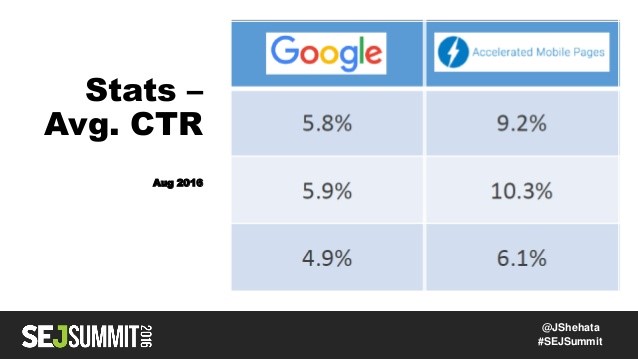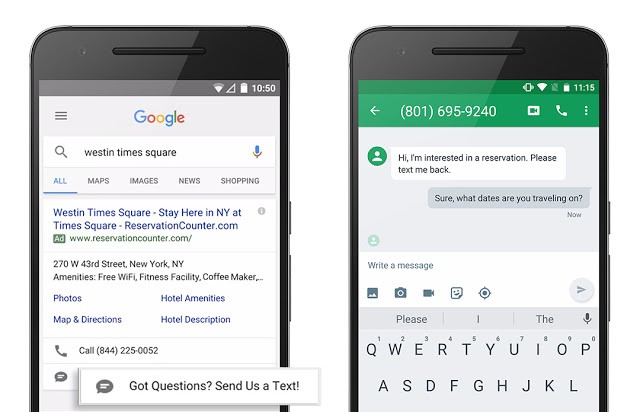Editor note: Want to help us learn more about the trends for next year? Answer our 10-minute 2017 digital marketing survey and win a $100 Amazon gift card!
As we near the end of another year, we begin to set our sights on the year ahead. The search marketing industry continues to evolve rapidly, and there will be no shortage of updates and alterations in 2017.
In today’s digital era, you should already be invested in a search marketing campaign. With Google’s heavy reliance on relevance in search, you need to be aware of the latest trends in marketing to ensure you stand out in all aspects of search.
Google and other search engines are further understanding search intent, delivering new opportunities for your business to rise to the top of results. For SEO and paid SEM campaigns, take advantage of all search marketing avenues to get your brand in front of as many eyes as possible.
Like this year, 2017 will see numerous expansions, including new challenges for marketers and SEOs. It’s time to start planning for 2017, so you’re ready as we ring in the New Year.
What We’ve Seen in 2016
It seemed like there was a major new feature, a new beta test, or a new update every few weeks. As the landscape shifted and we continued to be presented with better and more relevant results, the opportunities for SEOs have changed.
Let’s look at some of the updates we’ve seen throughout 2016, which are linked to great articles if you want to read and learn more about these updates and releases.
- Launch of AMP for Websites in February
- Removal of Sidebar Ads in SERPs
- Cross-Device Remarketing
- Micro-Moments to Connect With Buyers At Exactly the Right Time
- Session Quality Score Data
It’s a good idea to study these trends and features so you understand the future of search marketing and how to adjust your campaign. Strategic modifications should always be made to your campaigns, and 2017 will prove that point.
Here’s what to expect as we change the calendar over.
Accelerated Mobile Pages Will Develop Further & Become Critical to Search
As mobile search continues to grow, the importance of speed has become a focal point for users and Google alike. Accelerated Mobile Pages (AMP) has been the talk of the industry since its launch in February 2016.
With speed as a top need for brands and consumers, AMP loads quickly to provide the best user experience. The AMP pages are delivered from the Google-hosted cache version in the cloud, loading up to 30 times faster than non-AMP pages. You can see how this version of Anna Crowe’s article is delivered by Google.
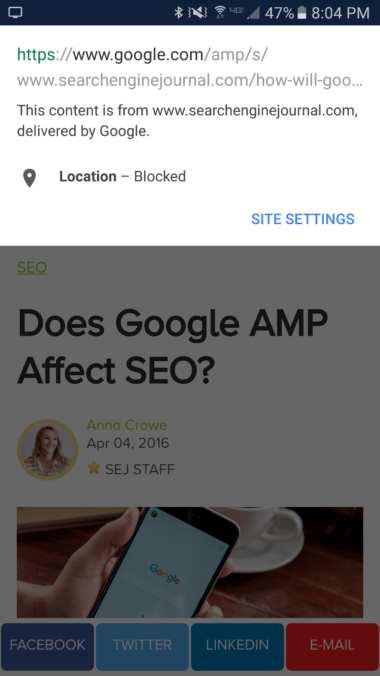
At the SEJ Summit in New York on November 2, John Shehata of Conde Nast presented on the importance of AMP. He said that although the majority of mobile search traffic is coming from regular Google search, AMP accounts for double the amount of traffic as newly published content.
It’s important to keep in mind that not all content types are suited for AMP. While it has become a part of main mobile search results, it is still only useful for news articles, blog posts, product listings, recipes, and other guides that are easily consumable.
Google’s Gary Illyes told Search Engine Land that “there is a very strong push for AMP everywhere. And you can expect more launches around that.” In recent months, Google has announced that AMP signals are ranking over a deep linked page within an app for the same thing.
There are over 700,000 domains publishing AMP pages, and many are monetizing with ads. Platforms like YieldMo and DoubleClick are supporting multi-size ad requests on AMP pages to protect the user experience.
In 2017, look for ads within AMP pages to take flight and more businesses to implement AMP into their posts and product pages. With a higher click-through-rate and higher rankings, AMP will continue to be the talk of the industry as webmasters and SEOs try to get the most from accelerated content.
To get started with AMP, utilize the official AMP WordPress plugin. Once installed and activated, the plugin will give all the new posts on your website an AMP version, which is dynamically generated and adds /amp/ to the end of your URL string.
The Innovations of AI Learning & Google RankBrain
Search continues to evolve. Gary Illyes said that Google will be focusing more and more on machine learning in the future, through it won’t take over the core algorithm.
Search is becoming smarter, learning your intent and delivering the best results. While RankBrain has become the third most important ranking factor, machine learning will continue to advance into the future. You should have already adjusted your content to focus on relevance and value as RankBrain continuously makes adjustments to rankings for a given query depending on the outcome.
As we advance our technologies, machine learning will take a different approach. Enter Google Assistant and Allo, the new Google messaging app.
In an article in Fast Company Magazine, John Giannandrea, Google’s VP of Search said,
“We think of the Assistant as of an evolution of Google search. It’s a superset in some senses. If you said to Google search, ‘Get me a pizza,’ nothing happens. Our aspiration is that the assistant will go and get you a pizza. We don’t today, but that’s our aspiration.”
And like pizza, when you ask Google Assistant or Allo to find you a local restaurant, hardware store, plumber, electrician, or other local business, Google’s AI will help you find the best answer. If you market your site to deliver the best experience and provide value by answering user intent, you’ll be ahead of the game when it comes to optimizing for machine learning advancements.
Keep in mind that non-traditional ranking factors will determine the results for any given query. With RankBrain, we’ve seen relevance as a key factor to great rankings. The higher your engagement rate and more relevant the page is, the better you’ll perform.
Through their machine learning and AI technology, Google understands the way we’re increasingly interacting with computers and search engines. Google’s launch of their new suite of products, including Google Home and Allo, come at a time that coincides with the search trend of voice search.
At Inbound 2016, HubSpot co-founders Brian Halligan and Dharmesh Shah predicted bots will make search more efficient as they begin to power websites. In an article on Forbes, Shah is quoted as saying, “The shortest time between a customer question and the answer will be a bot. It’s not human vs. bot; it’s human to the bot powered.” HubSpot is working on their own chatbot for sales and marketing professionals, called Growthbot.
Google will be focusing on updating their technology and ensuring it is superior to competitors like Microsoft, Amazon, and Facebook. For now, search marketers in 2017 should be aware of results displayed by artificial intelligence while focusing on optimizing for voice search.
Advancement of Voice Search for Search Marketing
Voice search will take a huge leap in the state of search marketing in 2017. We realize that search engines are getting smarter, and speaking is easier than typing, especially when we need to be hands-free.
It’s no surprise that Google is focusing on voice search and natural language processing. During his keynote speech at Google I/O in May, CEO Sundar Pichai noted that 20 percent of US searches on the Google Android app are conducted through voice search.
What Does This Mean for Search Marketing?
Businesses continue to search for ways to adopt this feature as more and more users adapt to using their voice for search. Back in May, Bing announced that a quarter of their search queries are voice searches, and it’s safe to say that number has and will continue to increase on both Google and Bing.
It’s been six years since Google Voice Search was announced. Since that announcement, speech recognition technology has improved to the point where search intent is much clearer. You’re asking a question that you require an immediate answer, so think about how to leverage that data in 2017.
Say, for instance, you wanted to find out who the New York Giants were playing next week. In today’s instant era, would you go to the Google app or browser and type in your query? Or would you go to Siri, Cortana, Amazon Echo or Google and ask them?
We’d ask them. It’s what we’ve become accustomed to. They’ll answer with something along the lines of, “The New York Giants will take on (insert team) on Sunday at 1 pm.” It’s convenient.
Digital Assistants will advance even further throughout 2017, redefining the way we search.
- Look for natural language queries within analytics.
- Set up your pages to answer specific, in-depth questions.
- Use a conversational tone in your published content.
- Determine how people will phrase queries through voice search.
Search Engine Journal’s Executive Editor, Kelsey Jones, caught up with Purna Virji, Microsoft’s Senior Training Manager, at Pubcon to discuss voice search. Virji says marketers should take action on high intent questions and leverage content marketing or FAQ pages to assist optimizing through particular voice searches.
As we’ve had to learn machine language queries, the machines are now learning our language. Focusing on long-tail queries and natural language, you can leverage your marketing campaign for voice search.
The Race for Featured Snippets
Voice search will give more prominence to brands who land a featured snippet. I wrote an in-depth guide that gives tips on how to land a featured snippet for a long-tail, specific search query.
Featured snippets include the brand, a link to the page where the answer is found, and a quick answer box that delivers the best answer to a question right from the results. For all searches, the potential for traffic is increased tenfold when you hold a featured snippet, and voice search shows more potential.
For voice searches, the digital assistant you’re using will reinforce your brand. For example, Google Now will tell you, “According to Search Engine Journal…” which presents a unique branding opportunity in your search marketing campaign.
Featured snippets are present in 43.3% of voice queries, as compared to 40.6% of text queries, according to Jennifer Slegg of the SEM Post.
It’s going to be a race for featured snippets throughout the year as brands realize the potential to increase their traffic and conversions. Voice search will play a huge role in this trend.
New Opportunities Will Be Seen in Paid Search Advertising
There have been changes and updates to the Google AdWords interface all year. We’ve mentioned the redesigned SERPs page, presenting more ads and less blue links.
Advertisers will be presented with new features and tactics to take their marketing to the next level. As advertisers realize that experience based marketing helps bring your products in front of customers interested in buying before they see the ad, strategies will change.
From native ads to personal targeting and marketing automation, there will be new and exciting opportunities to take advantage of as we head to 2017.
Similar Audiences for Search: Reach new audiences with similar search behavior as your current customers. If you’re running effective remarketing ads and have seen success with RLSA, similar audiences for search can increase your reach on Google Search.
YouTube Unique Reach Audience: View the demographics that are seeing your ads, and format those demographics to measure how many people saw your TrueView ads and how many times they saw them. This metric is available in select YouTube markets and provides value when you’re running reach-based campaign KPIs.
Click-to-Message Campaigns: Appealing to all users, especially those on the go with limited time to speak with a salesperson or customer service representative, AdWords is introducing click-to-message campaigns for businesses to engage customers in a new way: texting. A text icon will appear in a search ad. The feature benefits both large and small businesses, as users may prefer to text for assistance or more information before making a purchase decision.
Promotion Extensions: Are you running a special promotion for a limited time? Highlight your sales and promotions across your ads without having to update every single ad group or creative. Perfect for holiday sales or specific discounts, the extensions alert users about particular promotions. The new search ad format is beginning to roll out, and advertisers can take advantage of this for their next promotion.
Dr. Pete Meyers of Moz shared his findings of a Williams Sonoma ad full of extensions—including the new promotion extension.
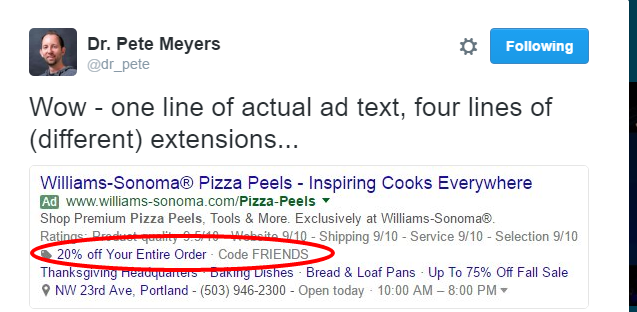
There is sure to be additional opportunities in the coming months, giving advertisers new and unique ways to reach a broader audience by making communication more convenient. They will refine and beta test new areas to provide the best user experience as we move forward into 2017.
More Video, Please
As you look for assisted conversions and a way to improve brand awareness in the New Year, video content marketing will be trending upward.
New mobile technology has led to widespread consumption of video. Publishers and brands are analyzing the best ways to include video in their content and search marketing strategies.
The focus will shift to YouTube. According to Think With Google, 85% of adults ages 18-49 use multiple devices at the same time, while two-thirds of users watch YouTube on a second screen while watching TV at home. Video and video ads present more opportunities and more chances to reach your target consumers.
With the focus on online video, once you release a video on YouTube, promptly share it on relevant social platforms for that content. Plus, with YouTube Unplugged set to launch in 2017, it remains to be seen how advertisers can take advantage of the subscription TV service.
Regarding social media, there are multiple ways to keep your business in front of your audience. Facebook’s introduction to live videos, Instagram’s inclusion of Stories and Snapchat’s release of Spectacles is going to transform the way brands and businesses can promote their content in consumable, engaging formats.
These three avenues of video are trending toward the way we tell visual stories. It’s a way to nurture relationships and create an experience that resonates with your audience. Brands will be experimenting with video, from original creations to brand storytelling to brand awareness throughout 2017, and audiences will consume more video than ever.
Leverage your search marketing and assisted conversions with the utilization of video content marketing.
A Closer Look at Progressive Web Apps
Again, we’re looking at the shift to a mobile web. Google has just announced their mobile first index, which will prioritize and index a mobile site ahead of a desktop site. You can learn more about mobile first indexing here. With Progressive Web Apps, you’ll see an app-like experience within your mobile browser.
Complement your SEO efforts and your website with PWAs, delivering an amazing user experience. It’s an app-like experience on a normal mobile browser. While not necessary for every company, it can aid and benefit your search presence.
For users with limited internet access, PWAs offer low data usage and an easier navigation with its highly responsive layout. While some brands have begun to take advantage, look for this aspect of search marketing to progress throughout 2017 and beyond.
Using HTML 5 and a JavaScript interface, PWAs load fast to dynamically display content. They are installable and live on the user’s home screen without the need for an app store.
It’s the future of your mobile experience. A high-quality PWA comes with numerous benefits, as laid out by Google. Grow your engagement and improve conversions as the Progressive Web App works no matter the network condition a user is facing. Your browser, according to a Moz overview on PWAs, will be able to deliver push notifications, background sync for updating data, offline caching, and more, mostly loaded through AJAX.
Google is focusing on the development of PWAs as the next generation of online interactivity, which can now be audited with the chrome extension Lighthouse, an automated tool to improve the quality of your web app.
Marketers and brands are beginning to realize that not everyone wants to download and install a traditional app on their device. Traffic is continuing to shift from desktop to mobile, so think about incorporating a PWA into your marketing strategy to complement your search campaigns and provide as best an experience as possible.
Increased Attention to Schema Markup
User trends are shifting, and their experience is defined more and more by the capabilities of schema markup. Marking up the HTML on your website aids in the health of your search marketing strategy.
Its development helps search engines understand semantics through Resource Description Framework Schema. When implemented correctly, Schema helps Google index the pages more accurately.
Additionally, Schema is what Google will look at when determining to display a rich card or featured snippet in search results.
Both these aspects will greatly improve your search visibility, impacting your presence in organic search. When preparing for 2017, “Schema can help make the purpose and content of your site clear, so your text is more appealing for a snippet boxes,” according to Search Engine Watch.
In 2017, focus your efforts away from site-wide schema, and make it page specific, depending on what you’re offering. The more accurate your schema information, the better experience for you, your users, and the search engines.
Wrapping Up
There is one thing that won’t change. Users will continue to search. The method may change, advance, and alter slightly, but search will be still a primary factor.
Staying up to date with the latest optimization tactics is a major piece to the 2017 search marketing puzzle. With a focus on mobile and incorporating mobile marketing into your search strategy, you’ll get ahead of your competition as strategies change in the New Year.
A new year means new opportunities to fine tune your search marketing campaign, integrating new tactics and advertising platforms. Create a documented strategy and raise the bar in 2017. Look at AMP, machine learning, voice search, and video marketing.
Is your brand ready for the new year? Search engine marketing takes time and commitment. With the new features and changes, you’ll have to stay focused and committed to achieving your goals. Keep an eye on the trends and your own metrics to see how your marketing efforts are improving. It’s going to be an exciting year ahead.
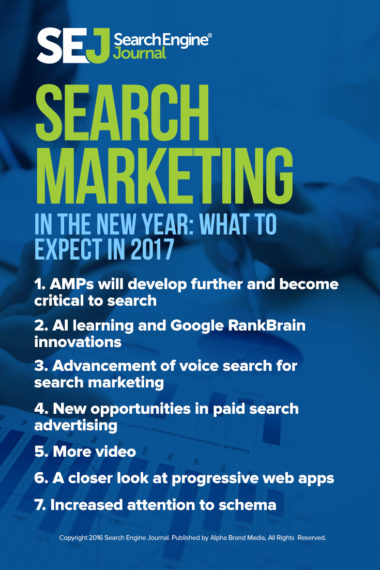 Featured Image: Image by Gabrielle Frake. Used with permission.
Featured Image: Image by Gabrielle Frake. Used with permission.
All screenshots by Ryan Clutter. Taken November 2016.


